Megadim, Tel
RENEWED EXCAVATIONS
M. Broshi’s 1967–1969 excavations at Tel Megadim (Tell
EXCAVATION RESULTS
THE CHALCOLITHIC PERIOD. No structures can be firmly associated with the Chalcolithic period, but it is clear that the site was occupied then from the quantity of pottery sherds, basalt vessel fragments, and flint tools found in fill layers upon and within depressions in the bedrock.
THE EARLY BRONZE AGE I. The Early Bronze Age IB stratum, consisting of several architectural phases, was nestled against the leeward side of a kurkar ridge running north–south, located meters from the ancient coastline. The unwalled Early Bronze Age IB settlement was one of the largest occupations at the site, perhaps larger than the Persian stratum, encompassing as much as 5 a. The architectural units were characterized by curvilinear and rectangular buildings, the latter often with 90-degree interior corners and rounded exterior corners. In addition, a circular tower-like structure was exposed (external diameter 5.20 m, internal diameter 2.25 m), featuring smashed, flat-based, bow-rim storage jars on its floor. Several cylinder seal impressions were found on the jars. Other finds include dozens of basalt vessel fragments, a large flint tool assemblage, and one animal figurine. The majority of the Early Bronze Age pottery dates to the Early Bronze Age IB, but sherds from the Early Bronze Age IA and II were also found. Petrographic analysis of the pottery demonstrates that several regions of manufacture are represented. The Early Bronze Age IB stratum at Megadim can be compared to contemporary assemblages from Qiryat Ata, ‘Ein Assawir, Tel Qashish, Megiddo, and ‘En Shadud.

THE EARLY BRONZE AGE IV. Excavations revealed sparse architectural remains and a varied ceramic assemblage from the Early Bronze Age IV. The architecture was feeble compared to the relatively massive walls from the preceding Early Bronze Age IB. In one area, walls and surfaces were erected above a huge pit containing a large amount of ceramics and many animal bones and flint tools, suggesting that the occupation was not ephemeral. In addition, an updraft pottery kiln with a central pillar was discovered. Its lower firing chamber measured 1.5 m in diameter, and its walls, mud plastered on the inside, were preserved to a height of 40 cm. The handmade pottery assemblage belongs to a western variant (Carmel coast, northern Sharon Plain) of Dever’s North Central group, lacking red-slip surface treatment. One type (a closed bowl or krater, now referred to as Megadim ware), with a cream-colored surface burnished on the interior and exterior, is of special interest. Some handles are vertical and spike shaped, others horizontal with two pierced holes. Petrographic analysis conducted on one rim sherd indicated that it was locally made. No parallels for these vessels were found.

THE MIDDLE BRONZE AGE II. Only partial architectural remains were uncovered from the Middle Bronze Age II, due to the disturbed nature of the excavated area. Portions of rooms with installations (tabuns, silos, etc.), all apparently of domestic character, were exposed. The appearance of Cypriot cross-line style juglets in a Middle Bronze Age IIA refuse pit is significant.
The most impressive finds from the Middle Bronze Age consist of tombs and their contents. Three types of tombs were discovered: large masonry chamber tombs, masonry cist tombs, and jar burials. Two masonry chamber tombs, both for multiple burials, were excavated. One was originally constructed in the Middle Bronze Age IIA; most of its contents were discarded in the late Middle Bronze Age IIB/early Middle Bronze Age IIC, and new burials with offerings were laid. Excavation of the tomb yielded c. 70 vessels, mostly complete, including many dipper and cylindrical juglets, Tell el-Yehudiyeh juglets, Cypriot and Syro-Cilician vessels, five scarabs, two socketed spearheads, a bronze toggle pin, and dozens of beads. The second chamber tomb, dated to the Middle Bronze Age IIC, contained more modest finds, with two storage jars, each with a dipper juglet inside, several platters and carinated bowls, one Tell el-Yehudiyeh juglet, two Cypriot vessels, an alabastron, fragments of a carved bone inlay, and a bronze knife. Eleven cist tombs were interred with individual burials. They date to the Middle Bronze Age IIA, and contained many red-slipped and burnished jugs, Levantine painted ware juglets, and an Egyptian alabaster crescent-shaped pommel. The jar burials, probably dating to the Middle Bronze Age IIB and IIC, included the remains of children. Ceramic vessels had been placed inside the jars.
THE LATE BRONZE AGE. A small exposure of the Late Bronze Age II stratum, located directly under the Persian period remains excavated by Broshi in area C, revealed several rooms, presumably domestic in nature. One silo penetrating into the earlier Middle Bronze Age stratum was also found. The many Cypriot imports retrieved in this limited exposure attest to the significant role Megadim played in international trade of the period.

THE PERSIAN PERIOD. Remains from the Persian period, dating to the fifth century BCE, were found only at the northern and southern extremities of the excavation area. At the northern end, rooms belonging to several phases were uncovered in the recent excavations. These may supplement the results of Broshi’s excavations in presenting a more complete and hopefully more accurate plan of the Persian period settlement. The rooms were domestic in nature, containing tabuns and the typical pottery assemblage of the period. One unusual feature, dating to the Persian period or possibly later, was a large silo or granary (internal diameter at top c. 3.75 m) with an exhaust chute that led from its base outward and upward. Remains of a kurkar rampart were revealed at the southern end of the excavation area. This feature accounts for the stepped-like contour of the southern part of the tell.
The ceramic assemblage, which dates to the fifth century BCE, is characterized by the presence of basket-handled amphorae, straight-shouldered storage jars, mortaria, Aegean amphorae, and Attic black glaze and East Greek ware. Special finds include a portable altar made of kurkar stone, dozens of terracotta figurine fragments, two fibulae, lead net weights, and one “Scythian” arrowhead. The high percentage of storage jars and imported amphorae (basket-handled and Aegean types, especially from Chios) suggests that the Persian period site was commercial in nature. It not only served as an entrepôt for down-the-line maritime traffic, but may have also been a starting point for traders heading east, as access through the Carmel Ridge via

THE BYZANTINE PERIOD. A near-complete stone-paved structure dating to the Byzantine period was found at the far northern end of the excavated area. The character and size of this structure (c. 14.5 by 11.5 m) is comparable to the building cleared by Broshi at the summit of the tell (known as the Mutatio Certha), and reinforces his interpretation of the Byzantine settlement as a horse-changing station. Isolated ceramic, glass, and numismatic finds date this stratum to the late fifth/early sixth centuries CE, thus narrowing the general Roman–Byzantine date ascribed by Broshi.

RECENT UNDERWATER FINDS OFF MEGADIM
Echo soundings off the coast of Megadim revealed a submerged kurkar ridge which served as a natural breakwater. An entrance through this ridge was recently discovered near Megadim. An Early Bronze Age I Egyptian jar containing Aspatharia rubens, a freshwater mollusk from the Nile River, was found nestled against this kurkar ridge, thus providing evidence that the shores off Megadim served as an anchorage for ships plying the Egypt–Byblos route during the Early Bronze Age I. The discovery of many stone anchors offshore confirms that this area was used as an anchorage, as does the presence of shipwrecks from the Iron Age I (unexcavated) and the Hellenistic and Mameluke periods (see Marine Archaeology, in this volume).
SAMUEL WOLFF
RENEWED EXCAVATIONS
M. Broshi’s 1967–1969 excavations at Tel Megadim (Tell
EXCAVATION RESULTS
THE CHALCOLITHIC PERIOD. No structures can be firmly associated with the Chalcolithic period, but it is clear that the site was occupied then from the quantity of pottery sherds, basalt vessel fragments, and flint tools found in fill layers upon and within depressions in the bedrock.
